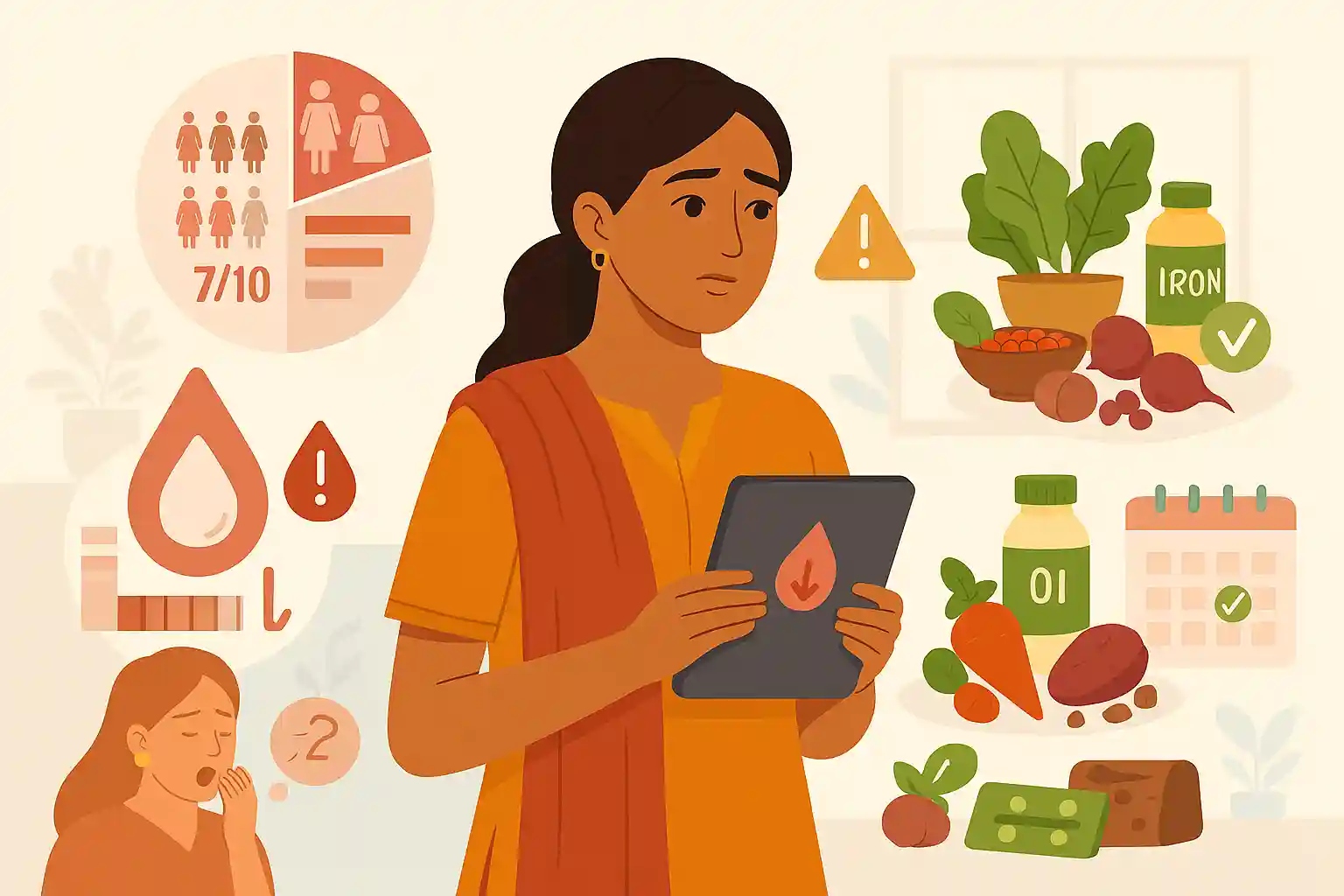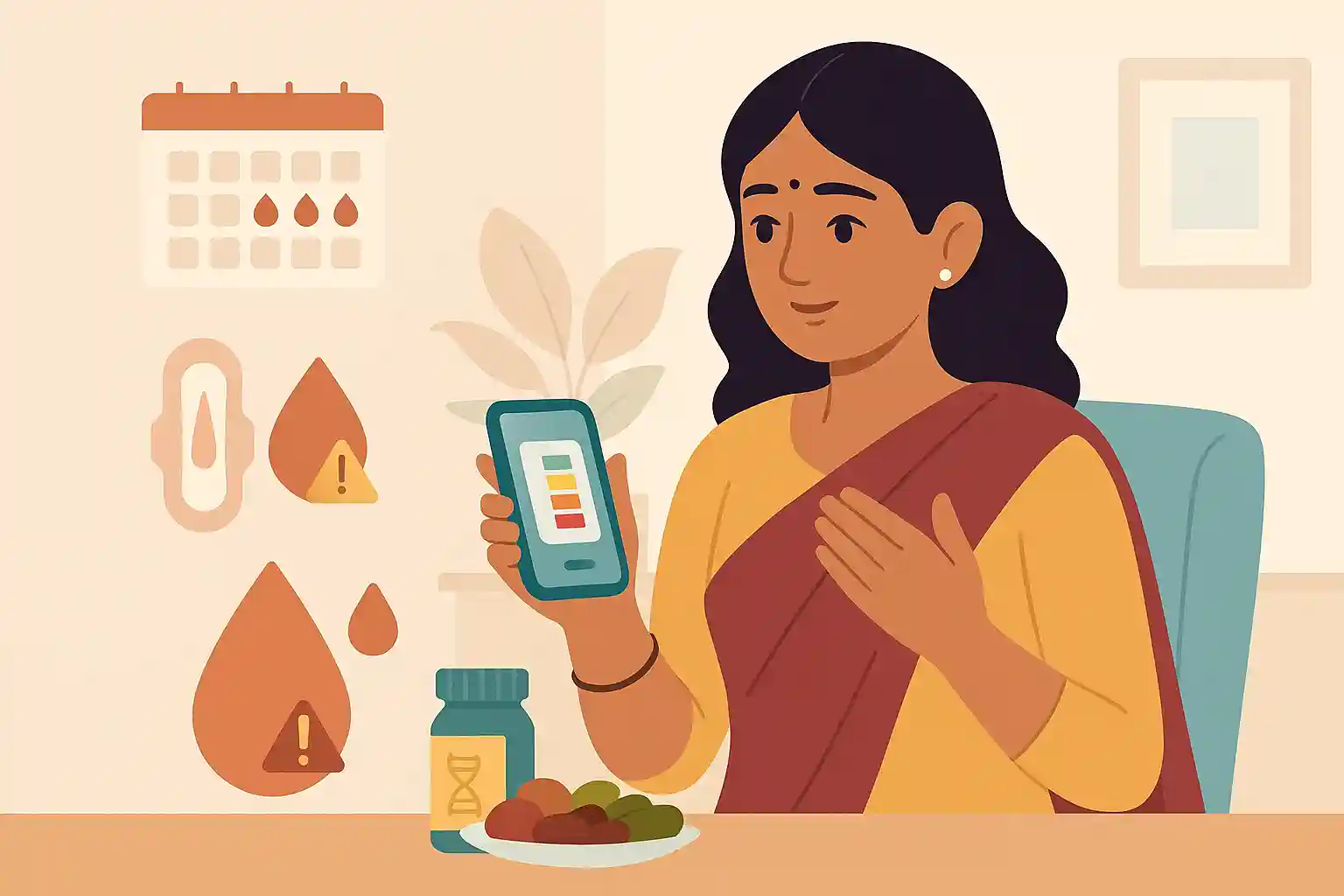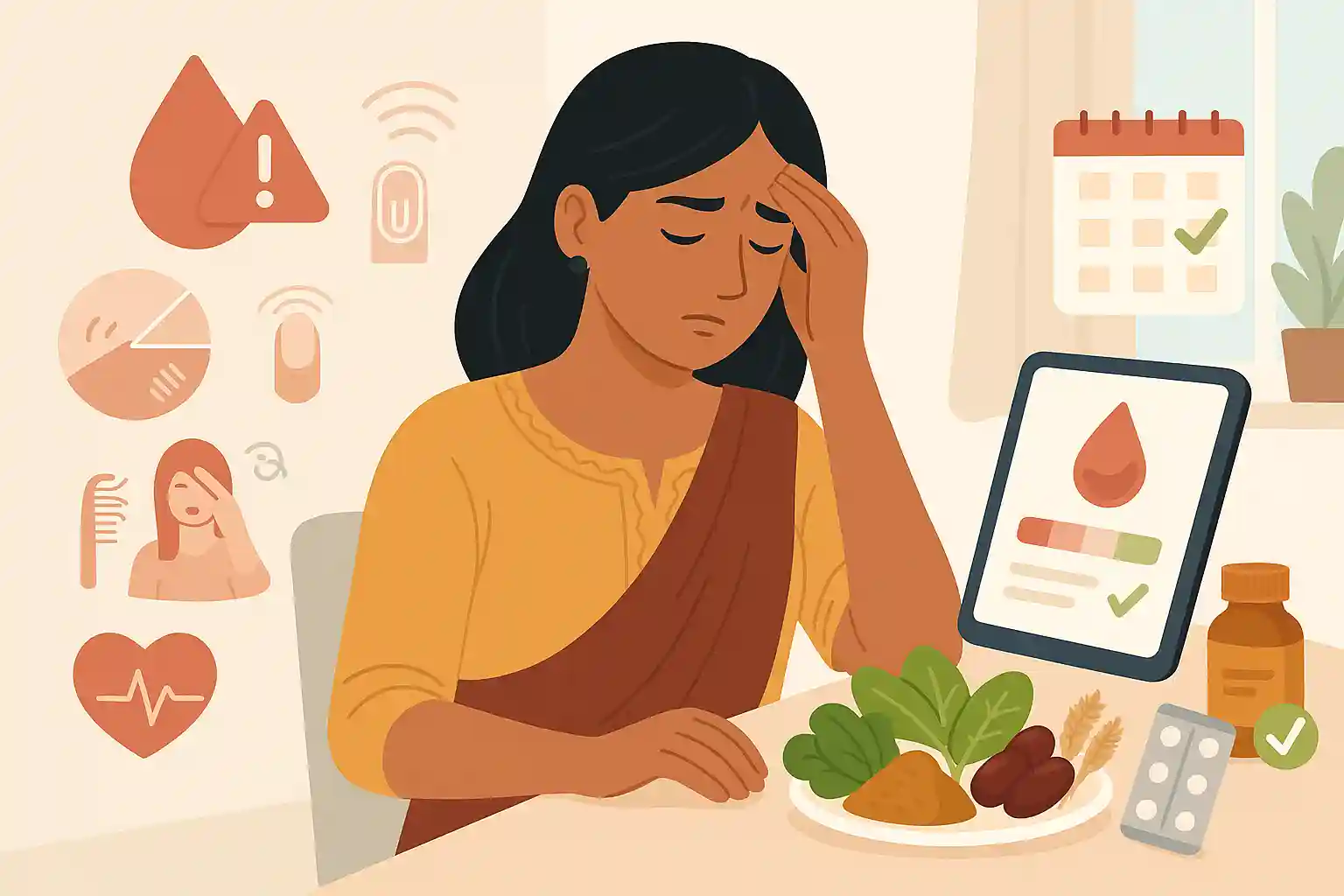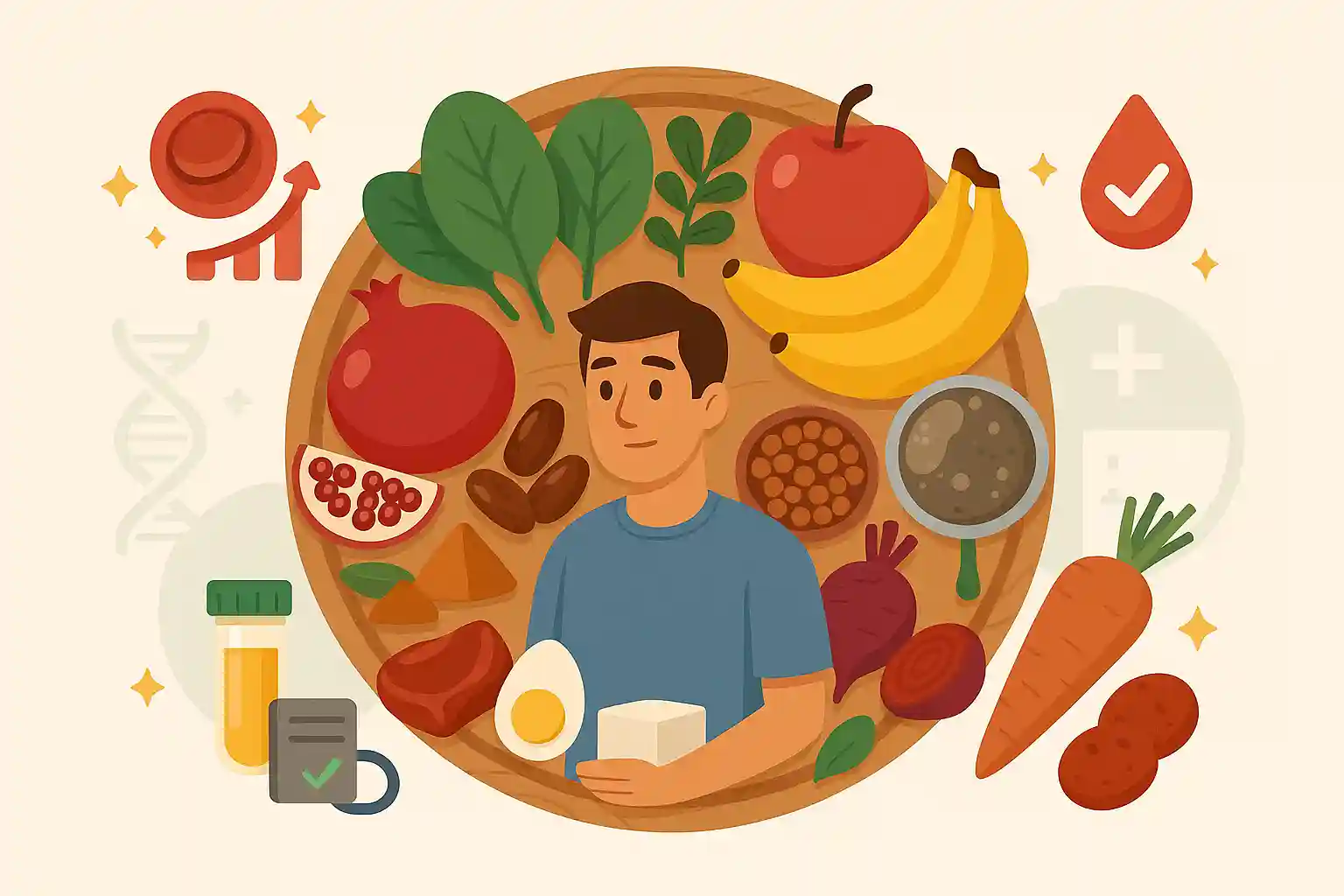A shocking 7 out of 10 Indian women suffer from anemia, making it one of the most widespread yet overlooked health crises in the country. This isn't just a number—it represents millions of women experiencing chronic fatigue, reduced productivity, compromised immunity, and increased health risks. The tragedy is that anemia is largely preventable and treatable, yet it continues to affect women across all socioeconomic backgrounds in India.
Whether you're a college student struggling with concentration, a working professional feeling constantly exhausted, or a mother unable to keep up with daily demands, understanding and addressing iron deficiency could be the key to transforming your health and quality of life.
The Alarming Reality: Anemia Statistics in India
The National Family Health Survey (NFHS-5) reveals devastating statistics about anemia in Indian women:
- 68.4% of women aged 15-49 are anemic
- Rural women: 70.4% affected vs. Urban women: 64.7%
- Adolescent girls (15-19): 59.1% are anemic
- Pregnant women: Over 50% suffer from anemia
- Women in tribal areas: Up to 80% prevalence rates
- Only marginal improvement from NFHS-4 despite government programs
These numbers indicate that anemia has reached epidemic proportions, affecting women regardless of education, income, or geographic location. The problem is so widespread that it's often normalized, with many women accepting fatigue and weakness as part of their daily reality.
Understanding Iron Deficiency and Anemia
Anemia occurs when your blood lacks enough healthy red blood cells or hemoglobin to carry adequate oxygen to your body's tissues. Iron deficiency anemia, the most common type, happens when your body doesn't have enough iron to produce healthy red blood cells.
Normal Hemoglobin Levels for Women:
- Non-pregnant women: 12.0-15.5 g/dL
- Pregnant women: 11.0 g/dL or higher
- Adolescent girls: 12.0 g/dL or higher
- Postmenopausal women: 12.0-15.5 g/dL
Severity Classification:
- Mild anemia: 10.0-11.9 g/dL
- Moderate anemia: 7.0-9.9 g/dL
- Severe anemia: Below 7.0 g/dL (requires immediate medical attention)
Why Are Indian Women Particularly Vulnerable?
Multiple interconnected factors create the perfect storm for iron deficiency in Indian women:
Biological Factors:
- Menstrual blood loss: Women lose 15-30mg iron monthly during menstruation
- Pregnancy and breastfeeding: Increased iron demands during reproductive years
- Multiple pregnancies: Close spacing depletes iron stores
- Early menarche and late menopause: Longer reproductive period increases iron loss
Dietary and Cultural Factors:
- Predominantly vegetarian diets with poor iron bioavailability
- Low consumption of vitamin C-rich foods with meals
- High consumption of tea and coffee that inhibit iron absorption
- Cultural practices where women eat last and least in families
- Preference for polished rice and refined wheat over whole grains
- Limited access to diverse, nutrient-rich foods
Socioeconomic Barriers:
- Poverty limiting access to iron-rich foods
- Poor sanitation leading to parasitic infections that cause blood loss
- Limited education about nutrition and health
- Inadequate healthcare access for early detection and treatment
- Work demands preventing proper rest and nutrition
- Gender inequality affecting resource allocation within households
Recognizing the Silent Symptoms
Anemia often develops gradually, making symptoms easy to dismiss. Many women adapt to feeling unwell, thinking it's normal. Watch for these warning signs:
Early Warning Signs:
- Persistent fatigue that doesn't improve with rest
- Weakness and reduced stamina during daily activities
- Pale skin, lips, nail beds, or inner eyelids
- Shortness of breath during routine tasks
- Cold hands and feet
- Brittle or spoon-shaped nails
- Frequent headaches and dizziness
Advanced Symptoms (Require Immediate Attention):
- Rapid or irregular heartbeat
- Chest pain or difficulty breathing
- Difficulty concentrating and memory problems
- Restless leg syndrome
- Cravings for non-food items (ice, starch, dirt)
- Heavy menstrual periods
- Frequent infections due to compromised immunity
The Hidden Costs of Anemia
Anemia doesn't just affect how you feel—it impacts every aspect of your life and has broader societal consequences:
Personal Impact:
- Reduced work productivity and earning potential
- Impaired cognitive function and learning ability
- Increased susceptibility to infections
- Complications during pregnancy and childbirth
- Reduced quality of life and mental health issues
- Higher healthcare costs for treatment of complications
Economic Impact on India:
- Loss of GDP estimated at 1-2% annually due to reduced productivity
- Increased healthcare expenditure on maternal and child health
- Reduced human capital development
- Intergenerational transmission of malnutrition and poor health
Powerful Iron-Rich Foods for Indian Women
The good news is that many traditional Indian foods are excellent sources of iron. The key is knowing how to combine them for maximum absorption:
Vegetarian Iron Powerhouses:
- Dark leafy greens: Spinach (palak), fenugreek (methi), amaranth (chaulai)
- Legumes and pulses: Masoor dal, chana dal, rajma, black-eyed peas
- Whole grains: Bajra, ragi, quinoa, brown rice
- Nuts and seeds: Sesame seeds (til), pumpkin seeds, almonds, cashews
- Dried fruits: Dates, raisins, dried apricots, figs
- Vegetables: Beetroot, tomatoes, bell peppers, broccoli
Non-Vegetarian Iron Sources (for those who consume):
- Lean meats: Mutton, goat meat, buffalo meat
- Poultry: Chicken, especially dark meat
- Fish: Sardines, mackerel, tuna, pomfret
- Organ meats: Liver (highest iron content)
- Eggs: Particularly egg yolks
Maximizing Iron Absorption: The Indian Kitchen Strategy
Simply eating iron-rich foods isn't enough—you need to optimize absorption:
Absorption Enhancers:
- Vitamin C sources: Amla, guava, tomatoes, lime, oranges, capsicum
- Cooking combinations: Dal with tomatoes, spinach with lemon juice
- Fermented foods: Idli, dosa, dhokla (improve mineral bioavailability)
- Cast iron cooking: Traditional method that adds iron to food
- Soaking and sprouting: Reduces phytates that block iron absorption
Absorption Inhibitors to Avoid:
- Tea and coffee: Wait 1-2 hours after iron-rich meals
- Calcium supplements: Take separately from iron
- Whole grains: Phytates can block absorption (fermentation helps)
- Dairy products: Can reduce iron absorption when consumed together
- Antacids: Can interfere with iron absorption
Smart Meal Planning for Iron Absorption
Here are practical meal combinations that maximize iron intake and absorption:
Breakfast Ideas:
- Ragi porridge with jaggery and almonds
- Spinach paratha with amla chutney
- Sprouted moong dal chilla with tomato chutney
- Fortified cereals with vitamin C-rich fruits
Lunch/Dinner Combinations:
- Masoor dal with tomatoes + bajra roti + guava
- Spinach curry + brown rice + lemon wedge
- Rajma curry + whole wheat roti + bell pepper salad
- Fish curry + tomato rice + lime pickle
Iron-Rich Snacks:
- Mixed nuts with dates
- Sesame seed laddu
- Beetroot and carrot juice
- Roasted pumpkin seeds
Medical Treatment: When Food Isn't Enough
While dietary changes are crucial, many women need medical intervention to restore iron levels:
Iron Supplements:
- Ferrous sulfate: Most commonly prescribed, 60-120mg daily
- Ferrous fumarate: Alternative for those with stomach issues
- Iron chelate: Better absorbed, fewer side effects
- Liquid iron: For those who can't tolerate tablets
- Take on empty stomach with vitamin C for better absorption
Managing Supplement Side Effects:
- Nausea: Take with small amount of food or at bedtime
- Constipation: Increase fiber intake and water consumption
- Dark stools: Normal and harmless side effect
- Stomach upset: Try different formulations or split doses
- Start with lower doses and gradually increase
When IV Iron is Needed:
- Severe anemia (Hb < 7 g/dL)
- Inability to tolerate oral supplements
- Malabsorption disorders
- Chronic blood loss
- Urgent need for rapid iron repletion
Testing and Monitoring Your Iron Status
Regular testing helps track your progress and prevent recurrence:
Essential Tests:
- At home tests: Finger prick hemoglobin test
- Complete Blood Count (CBC): Measures hemoglobin and red blood cell parameters
- Serum ferritin: Indicates iron stores (should be >30 ng/mL for women)
- Serum iron and TIBC: Assesses iron transport and binding capacity
- Transferrin saturation: Should be >20% for adequate iron status
Testing Schedule:
- Initial assessment: All iron parameters
- After 4-6 weeks of treatment: Hemoglobin and ferritin
- Every 3 months: During treatment phase
- Annual screening: For women at risk
- Before and during pregnancy: As recommended by doctor
Addressing Root Causes
Treating anemia isn't just about iron supplementation—addressing underlying causes is crucial for long-term success:
Managing Heavy Menstrual Bleeding:
- Consult gynecologist for evaluation of heavy periods
- Treatment of underlying conditions (fibroids, PCOS)
- Hormonal management when appropriate
- Nutritional support during menstrual periods
Treating Parasitic Infections:
- Regular deworming in endemic areas
- Improved sanitation and hygiene practices
- Safe drinking water access
- Proper food handling and cooking
Addressing Chronic Diseases:
- Managing inflammatory conditions that affect iron absorption
- Treating kidney disease that affects red blood cell production
- Controlling autoimmune disorders
- Regular monitoring of chronic conditions
Special Considerations for Different Life Stages
Iron needs vary throughout a woman's life, requiring targeted approaches:
Adolescent Girls (13-18 years):
- Higher iron needs due to growth spurts and menstruation
- Education about nutrition and menstrual health
- School-based iron supplementation programs
- Addressing body image issues affecting food intake
Reproductive Age Women (19-45 years):
- Pre-conception iron optimization
- Managing work-life balance affecting nutrition
- Family planning to space pregnancies adequately
- Regular screening and preventive care
Postmenopausal Women (45+ years):
- Lower iron needs but continued risk from poor diet
- Screening for gastrointestinal bleeding
- Managing chronic diseases affecting iron status
- Maintaining bone health with adequate nutrition
Government Initiatives and How to Access Them
Take advantage of available government programs for anemia prevention and treatment:
- Weekly Iron and Folic Acid Supplementation (WIFS): Free supplements for adolescent girls and women
- Anemia Mukt Bharat: National program targeting anemia reduction
- Pradhan Mantri Matru Vandana Yojana: Nutrition support for pregnant women
- Integrated Child Development Services (ICDS): Supplementary nutrition programs
- Public health centers: Free testing and treatment for anemia
- National Health Mission: Comprehensive healthcare including anemia management
Creating Your Personal Action Plan
Transform your iron levels with this systematic approach:
Immediate Steps (Week 1-2):
- Get tested for hemoglobin and iron status
- Consult a doctor about your results and symptoms
- Start iron-rich diet modifications
- Begin prescribed iron supplements if recommended
Short-term Goals (1-3 months):
- Establish consistent supplement routine
- Implement meal planning with iron-absorption optimization
- Address any underlying health issues
- Monitor symptoms and energy levels
Long-term Maintenance (3+ months):
- Regular monitoring with lab tests
- Sustainable dietary habits
- Preventive healthcare practices
- Education and support for family members
Breaking the Cycle: Empowering Future Generations
Addressing anemia in women isn't just about individual health—it's about breaking the intergenerational cycle of malnutrition and poor health outcomes. When mothers are healthy and well-nourished, they give birth to healthier babies with better iron stores, setting the foundation for lifelong health.
Every woman who takes control of her iron levels becomes an advocate for change in her family and community. By prioritizing your health, seeking proper treatment, and sharing knowledge with other women, you contribute to a larger movement toward better health for all Indian women.
Remember, you deserve to feel energetic, strong, and healthy. Anemia is not a life sentence, and it's not something you have to accept as normal. With the right knowledge, support, and treatment, you can overcome iron deficiency and reclaim your vitality.
Start today—get tested, make informed dietary choices, seek medical support when needed, and most importantly, believe that you deserve better health. Your future self, your family, and your community will benefit from the healthy choices you make now.



